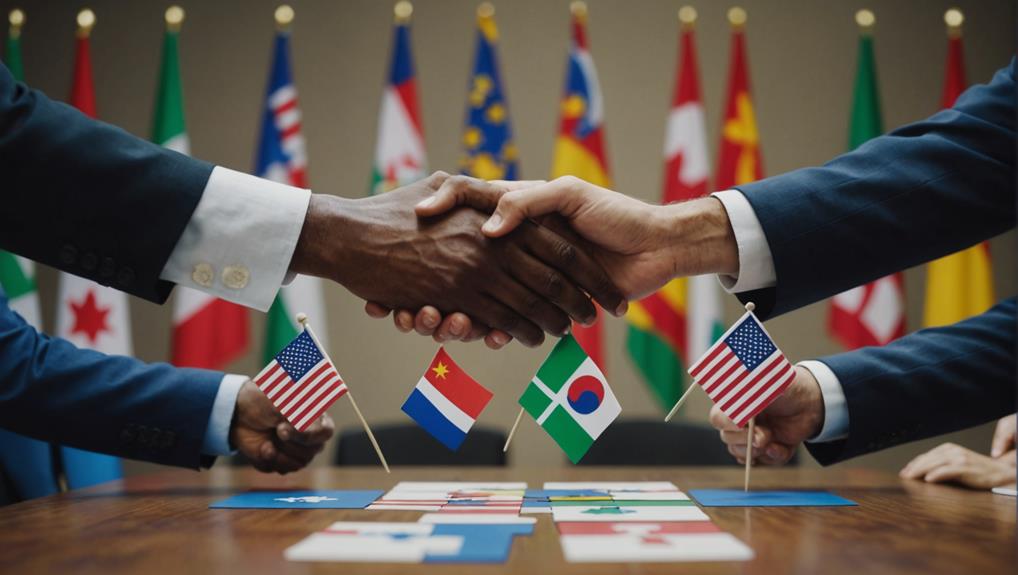The Role of Cultural Due Diligence in Mergers and Acquisitions

Cultural due diligence plays a critical role in mergers and acquisitions, ensuring successful integration and long-term sustainability. By evaluating organizational values, decision-making processes, and communication styles, we can pinpoint potential misalignments that may arise during the integration process.
It is equally important to address cultural considerations alongside financial and legal aspects. Effective cultural integration helps mitigate issues such as high employee turnover, communication breakdowns, and conflicting values, leading to a harmonious corporate environment.
Thorough cultural assessments and the development of alignment strategies are essential in navigating potential conflicts and realizing synergies post-merger. Understanding and addressing these cultural elements are key to achieving a seamless integration.
By conducting detailed cultural evaluations, companies can pave the way for a successful merger and acquisition, setting the stage for long-term growth and success.
Key Takeaways
Cultural due diligence plays a vital role in M&A transactions by identifying potential clashes that could arise during integration, thereby enhancing the overall success of the merger. By evaluating the core values of both organizations, cultural due diligence aims to ensure a smooth alignment and reduce the likelihood of employee discontent and morale issues.
Understanding the communication styles prevalent in each company is crucial for developing effective collaboration strategies and decision-making processes post-merger. This insight allows for a more seamless integration of teams and helps in bridging any communication gaps that may exist between the merging entities.
An early detection of cultural conflicts enables proactive measures to be taken, leading to a more streamlined integration process. By addressing these conflicts before they escalate, organizations can mitigate potential disruptions and ensure a smoother transition of operations post-merger.
Strong leadership and clear communication are paramount in fostering a unified corporate culture following a merger. By setting a clear vision and effectively communicating the goals and values of the newly integrated entity, leaders can help build a cohesive culture that aligns with the overarching objectives of the M&A deal.
Importance of Cultural Due Diligence
When engaging in mergers and acquisitions, conducting thorough cultural due diligence is paramount for successful integration and sustained prosperity. The significance of comprehending the cultural distinctions between the merging entities can't be overstated. Disregarding these differences isn't a minor oversight; it can be a deal-breaker. Research indicates that a staggering 83% of M&A deals fail to enhance shareholder returns due to unaddressed cultural issues, highlighting the critical nature of cultural due diligence.
In the process of merging two companies, it's imperative that their organizational cultures align seamlessly. If there's a misalignment in fundamental values, beliefs, or practices, it can result in substantial integration hurdles, such as a high rate of employee turnover. Cultural due diligence should be regarded as equally essential as financial and legal considerations during the M&A process. Without it, even the most financially viable deals may encounter obstacles.
A comprehensive understanding and assessment of cultural compatibility are crucial. Evaluating shared values and leadership approaches is essential to ensure a smooth transition and establish long-term prosperity. Utilizing tools like employee surveys, leadership evaluations, and cultural audits enables us to measure cultural fit and alignment accurately, ensuring that the merger results in the formation of a cohesive, flourishing entity.
Key Components of Cultural Assessment
When evaluating the cultural aspects of mergers and acquisitions, the initial step involves examining the alignment of organizational values and analyzing communication styles.
It's essential to ensure that both companies involved in the merger share similar fundamental values to facilitate a harmonious work environment.
Understanding how each organization communicates internally can uncover potential obstacles and opportunities for a smoother integration process.
Organizational Values Alignment
Assessing organizational values alignment is key in determining how well the core values, beliefs, and behaviors of merging companies coincide. Our cultural assessment centers on the congruence of organizational values to ensure a smooth integration process. We analyze whether the foundational principles that steer each company's culture, such as creativity, collaboration, and integrity, closely match.
Values alignment goes beyond shared ideals to encompass how these ideals translate into daily practices. We examine decision-making procedures, leadership styles, and work routines to ascertain if there's a seamless fit.
For example, if one company prioritizes quick, adaptable decision-making while the other leans towards a more hierarchical approach, this contrast could indicate potential conflicts.
Moreover, we consider workplace environments and employee expectations as reflections of underlying cultural values. A mismatch in this aspect can result in discontent and decreased morale, jeopardizing the success of the merger.
Communication Styles Analysis
We delve into communication styles to unveil how information flows within the merging organizations and uncover potential integration challenges. By analyzing these communication styles, we can identify barriers and opportunities that may arise during the integration phase. Varied communication styles often result in misunderstandings and conflicts post-merger, impeding the seamless blending of corporate cultures.
Our cultural due diligence process examines how each entity communicates internally and externally. This enables us to devise effective communication strategies that cater to the needs of both organizations. Analyzing communication patterns isn't just about spotting potential problems; it's about creating solutions that facilitate smoother mergers.
Understanding these communication styles allows us to implement strategies that promote clear, consistent, and efficient information exchange. This alignment is crucial for enhancing collaboration and improving decision-making processes within the newly formed entity.
When communication styles are harmonized effectively, the merged organization can function more cohesively, fostering innovation and efficiency.
Strategies for Evaluating Culture

When evaluating culture in mergers and acquisitions, it's crucial to conduct a thorough examination of the core values and communication styles within both organizations. By delving into the fundamental beliefs that underpin employee behavior and decision-making, we can better understand the cultural compatibility and potential areas of conflict that may arise.
Additionally, analyzing how teams communicate, whether through formal channels or informal networks, allows us to pinpoint areas of alignment and integration needs.
Assessing cultural fit is a key aspect of successful mergers and acquisitions, as it can greatly impact the overall integration process and the long-term success of the combined entity. Understanding the cultural nuances and dynamics at play within each organization can help identify potential challenges and opportunities for synergy.
By taking a deep dive into the cultural fabric of both companies, stakeholders can make more informed decisions and develop strategies to navigate any cultural differences that may arise during the integration process.
Assess Core Values
When evaluating core values in cultural due diligence for M&A deals, it's crucial to align these shared beliefs and principles with the business objectives and growth strategies of both companies. Understanding core values is key in mergers and acquisitions, as it helps identify potential cultural clashes and areas of synergy, which are essential for successful integration and long-term performance.
To effectively assess core values, consider the following factors:
- Ethical Standards: Do both companies uphold similar ethical practices, such as corporate social responsibility, environmental sustainability, and fair labor practices?
- Leadership Principles: How do the leadership styles and decision-making processes of the merging entities compare? This analysis can reveal potential conflicts or harmonious leadership dynamics.
- Employee Engagement: What values motivate and foster loyalty among employees in both organizations? Understanding this can help anticipate challenges in employee retention and integration.
Analyze Communication Styles
Effective communication styles play a crucial role in determining the success of post-merger integration and collaboration. When conducting cultural due diligence in mergers and acquisitions, it's essential to assess how information is shared and received within both organizations. This step is vital for anticipating potential challenges and ensuring a seamless integration process.
Analyzing communication patterns allows us to anticipate possible misunderstandings, conflicts, and productivity issues. By understanding the variations in communication styles, we can pinpoint barriers to effective collaboration and information flow, which are key to a successful merger.
For example, if one organization prefers direct communication while the other leans towards a more subtle approach, this disparity could lead to friction and inefficiencies. Evaluating communication norms also offers valuable insights into the overall organizational culture, shedding light on how teams interact, make decisions, and manage conflicts. These insights enable us to develop strategies to align different communication styles and nurture a cohesive working environment.
A thorough analysis of communication styles during cultural due diligence equips us with the knowledge necessary to bridge gaps and drive integration success. By proactively addressing these elements, we can reduce risks and improve the overall effectiveness of the merger or acquisition process.
Common Challenges and Solutions
Dealing with cultural differences in mergers and acquisitions can be a major challenge, but with the right strategies, successful integration is possible. Cultural discrepancies can result in a high turnover of key employees and hinder the achievement of M&A goals.
To address these issues, it's crucial to prioritize cultural due diligence, ensuring that the merging organizations are in sync regarding communication styles, decision-making processes, and management techniques. This alignment plays a crucial role in the success of M&A deals and in promoting effective organizational growth.
Through comprehensive cultural due diligence, potential misalignments can be detected early on, allowing for the implementation of corrective measures.
Here are some common challenges faced during M&A cultural integration and their corresponding solutions:
- Employee Turnover: Utilize detailed employee surveys and leadership evaluations to assess cultural compatibility and tackle any potential misalignments proactively.
- Integration Failures: Conduct cultural audits to assess and harmonize different communication styles and decision-making methods, facilitating smoother integration processes.
- Value Misalignment: Develop specialized training programs and workshops to align values and cultivate a unified corporate culture post-merger.
These solutions not only mitigate risks but also pave the way for a successful and innovative integration process. By addressing cultural issues preemptively, organizations can turn challenges into opportunities for growth and improved organizational development.
Case Studies of Successful Integrations

When Microsoft acquired LinkedIn in 2016, they strategically leveraged cultural compatibility to drive growth and innovation. By carefully examining cultural aspects during due diligence, Microsoft identified shared values with LinkedIn, such as a mutual dedication to empowering professionals and fostering innovation.
This alignment paved the way for a seamless integration process, allowing both companies to flourish after the merger. The shared vision of empowering professionals and organizations between Microsoft and LinkedIn was a key factor in their successful integration. Prioritizing employee empowerment and innovation ensured a smooth cultural transition.
Following the acquisition, LinkedIn saw substantial growth in its user base and revenue, showcasing the effectiveness of their cultural alignment strategy. Thorough cultural assessments played a crucial role in the long-term success of this merger. Microsoft's meticulous due diligence, which focused on cultural aspects, underscored the significance of aligning organizational values in mergers and acquisitions.
This case study demonstrates that cultural due diligence goes beyond a checklist and is essential for achieving a successful integration. For those in the SaaS industry, Microsoft's acquisition of LinkedIn exemplifies how emphasizing shared values and cultural compatibility can result in improved service offerings and sustained growth.
Best Practices for Cultural Integration
Drawing from successful mergers like Microsoft's acquisition of LinkedIn, we can pinpoint effective strategies for cultural integration that drive long-term success in M&A deals. An essential lesson learned is the significance of thorough due diligence, especially in cultural evaluation. By grasping the cultural landscapes of both entities, we can devise tactics that promote alignment and minimize conflicts.
Clear communication stands out as a pivotal element. Studies show that 57% of employees view transparent communication as crucial for productive collaboration. Establishing open channels to communicate the integration process's objectives, expectations, and timelines is imperative.
Another crucial aspect is strong leadership from top management. Research indicates that 70% of employees consider leadership as a key catalyst for successful integration. This underscores the importance of leaders embodying the desired cultural attributes and behaviors.
Conducting joint workshops and activities can significantly enhance employee engagement post-merger. Such initiatives have resulted in a 30% increase in engagement, fostering trust and collaboration among team members.
Frequently Asked Questions
What Is the Role of Culture in Mergers and Acquisitions?
Culture is a critical factor in mergers and acquisitions. It shapes how different teams communicate, ensures that the organizations are in sync, and boosts employee motivation. Integrating leadership effectively can encourage creativity and innovation, making the merger process smooth and successful. Prioritizing cultural due diligence is key to achieving the best outcomes in M&A transactions.
What Is the Significance of Cultural Due Diligence?
Without cultural due diligence, a staggering 83% of M&A deals end in failure. It is crucial to thoroughly assess and align the cultural aspects of both companies involved in the merger or acquisition. By focusing on leadership alignment, boosting employee engagement, and implementing innovative communication strategies, organizations can pave the way for a successful integration process.
Effective integration planning ensures a seamless merging of the two entities, creating a harmonious cultural environment that is conducive to growth and prosperity. By recognizing the importance of cultural due diligence, companies can avoid common pitfalls and increase the chances of a prosperous outcome post-transaction. Cultural harmony is not just a nice-to-have but a vital component in driving success in M&A deals.
Why Is Cultural Fit Important in M&A?
Cultural fit plays a crucial role in mergers and acquisitions as it can impact the success of the integration process. When leadership values are aligned, it can significantly boost employee morale and engagement, leading to a smoother transition post-merger. This alignment can help reduce conflicts and challenges that may arise during the integration phase.
Effective communication strategies are also essential in ensuring a successful merger. By establishing clear communication channels and promoting transparency, organizations can streamline processes and foster collaboration among teams from both companies. This open communication can spark innovation and new ideas, driving growth and success in the post-merger environment.
What Is the Role of Due Diligence in Mergers and Acquisition?
In Mergers and Acquisitions (M&A), due diligence plays a crucial role in assessing risks, analyzing finances, ensuring legal compliance, and facilitating seamless operational integration. This comprehensive evaluation is essential for developing innovative strategies that minimize potential risks and enhance the merger's chances of success.
Cultural due diligence in M&A involves examining the organizational cultures of the merging entities to identify any potential compatibility issues. By understanding the cultural differences and similarities between the companies, organizations can better plan for a successful integration process. Research has shown that neglecting cultural due diligence can lead to post-merger challenges, such as employee disengagement and decreased productivity.
Incorporating cultural due diligence into the overall due diligence process can help M&A deals achieve their intended synergies and improve long-term performance. By proactively addressing cultural differences and aligning values and behaviors, organizations can create a more cohesive and productive work environment post-merger. Studies have demonstrated that companies that prioritize cultural integration during M&A transactions are more likely to realize the full benefits of the deal and sustain growth over time.
Conclusion
Cultural due diligence plays a crucial role in mergers and acquisitions. Surprisingly, more than 70% of mergers fail primarily due to cultural misalignment.
By conducting comprehensive assessments of cultural fit, implementing effective evaluation strategies, and addressing common challenges, we can significantly increase our chances of successful integration.
Case studies highlight the importance of best practices, demonstrating that attention to cultural factors isn't just beneficial—it's essential.
Prioritizing culture is key to driving sustainable success in every merger and acquisition.